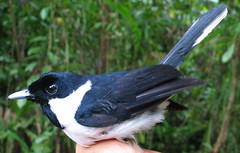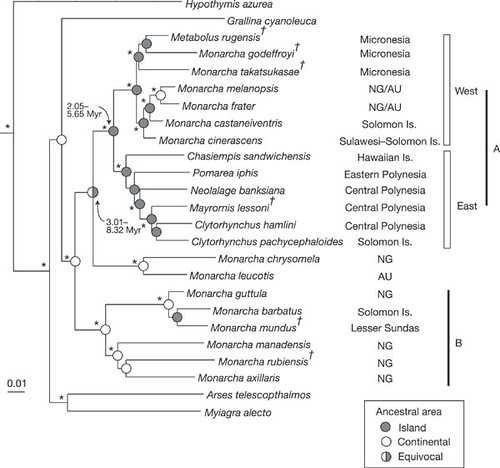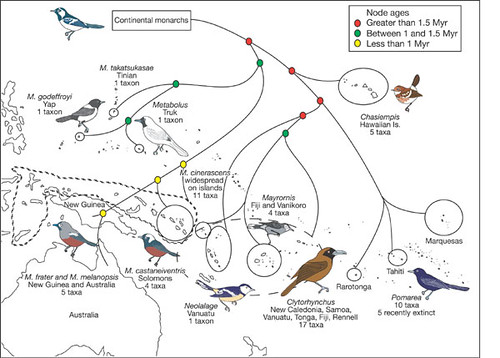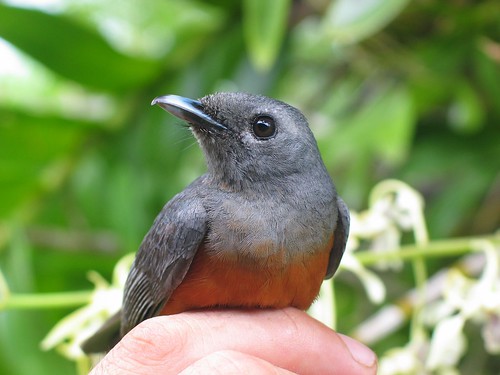tags: evolution, biogeography, ornithology, birds, avian
Kolo Sunset.
Photo credit: Christopher E. Filardi, American Museum of Natural History
(Click on image for a larger picture).
Two of my ornithologist colleagues, Chris Filardi and Rob Moyle, published a paper in the top-tier research journal, Nature. This paper is especially exciting because it shows that oceanic islands are not necessarily the evolutionary "dead ends" that they have traditionally been portrayed to be. In fact, Chris and Rob's data show that a group of birds have actually accomplished what scientists had never previously been able to document; some island species doubled back and successfully re-colonized the continents from where they originated.
Historically, scientists thought that continental species colonize island chains by hopping from one nearby island to the next in a stepping-stone fashion as they progressively moved away from the mainland. This "stepping stone hypothesis" was based on traditional methods for categorizing measurements of certain physical characteristics, such as beak shape, collected from different bird species. These morphological data were analyzed to build family trees based on the numbers and relative similarities of shared physical characters between bird species found on different islands. Using these data, taxonomists thought that those island bird species that most resembled each other also tended to be located within the same island chain, while remote islands hosted birds that were more distantly related. Thus, traditional hypotheses about speciation were built upon the assumption that geographically isolated species were also most likely to be evolutionarily distant.
However, many of these physical characters, especially beak shape, were later discovered to be particularly malleable and will quickly change in response to environmental demands. Because birds located on neighboring islands often live under comparable environmental demands, those particular morphological characters tend to be similar, even when the birds are not closely related. As a result, traditional taxonomic methodologies can provide data such that distant relatives are erroneously classified as close cousins.
 The model system supporting the stepping stone hypothesis are the Monarch Flycatchers (Monarchidae), an Australasian family that comprises approximately 60 species of birds. These small- to medium-sized passerines are also widespread throughout the islands and archipelagos of the Pacific Ocean as the result of historic colonization events. Island Biogeographer Ernst Mayr, who first proposed the stepping stone hypothesis, completed most of the studies of this group using traditional taxonomic methods. These taxonomic data suggested that species colonize island chains by moving in only one direction -- away from continents. Because the biological traffic appeared to be one way, this implies that islands are evolutionary dead ends, which is one of the predictions of the stepping stone hypothesis. But the DNA data from the Monarchs conflict with the taxonomic data, and reveal that this is not necessarily always true.
The model system supporting the stepping stone hypothesis are the Monarch Flycatchers (Monarchidae), an Australasian family that comprises approximately 60 species of birds. These small- to medium-sized passerines are also widespread throughout the islands and archipelagos of the Pacific Ocean as the result of historic colonization events. Island Biogeographer Ernst Mayr, who first proposed the stepping stone hypothesis, completed most of the studies of this group using traditional taxonomic methods. These taxonomic data suggested that species colonize island chains by moving in only one direction -- away from continents. Because the biological traffic appeared to be one way, this implies that islands are evolutionary dead ends, which is one of the predictions of the stepping stone hypothesis. But the DNA data from the Monarchs conflict with the taxonomic data, and reveal that this is not necessarily always true.
"The original source [for these birds] was continental, but if you look at island lineages and analyze all the unique forms at once, as we have, you find that the Pacific is an engine of diversity ... that can contribute to continental diversity," explained Chris Filardi, lead author of the paper, in a late-night telephone conversation.
These data were exposed using powerful DNA technologies that quickly reveal important details that were previously undetectable by traditional taxonomic methodologies. These DNA data were statistically analyzed to build a family tree, known as a phylogeny, for these birds (Figure 1, below).
Figure 1: The tree is rooted with Machaerirhynchus and Rhipidura (not shown). Daggers indicate taxa for which DNA was extracted from museum study skins and are represented by mitochondrial DNA only. Asterisks indicate nodes receiving more than 0.95 posterior probability and/or more than 70% maximum-likelihood bootstrap support. General geographic distributions are indicated to the right of taxon names. Ancestral area assignments for nodes are based on maximum-likelihood-based reconstructions (see Supplementary Information for details). Node age ranges were estimated with rates of 0.01 and 0.0276 substitutions per site per lineage per million years (see Supplementary Information). NG, New Guinea; AU, Australia. [Click image to see larger version in its own window].
The resulting phylogeny suggests that speciation patterns of the Pacific Monarch Flycatchers are more subtle and complex than previously thought. For example, these birds diversified from a single continental colonist which then expanded outward from its island home (Figure 2, below) - instead of speciating after a recurring series of colonizing island "hops" away from Australasia, as implied by the older taxonomic data.
Figure 2: Bird drawings are roughly to scale and illustrate some of the marked morphological differentiation between island endemics that has complicated the evolutionary interpretation of the group. Coloured circles indicate three classes of node age by using point estimates from ND2-specific rate calibration. Branch lengths are not to scale. The image representing the continental monarchs (Monarcha verticalis) is typical of taxa within clade B (Fig. 1). Large hatching outlines the distribution of Clytorhynchus and small hatching outlines the range of M. cinerascens. [Click image to see larger version in its own window].
According to Rob Moyle, co-author of the paper, the DNA data also revealed that the oldest monarch lineages inhabit the most remote Pacific islands while younger species groups are closer to the continental source area, New Guinea. This finding is contrary to "stepping stone" predictions. Additionally, the DNA data show that species that were previously classified into six different groups, or genera, are actually embedded within another genus, Monarcha (Figure 1). This shows that the birds are actually more closely related than suggested by their physical characteristics alone.
These data will refine our understanding of the role of oceanic islands as potential sources of global biodiversity.
"People have always assumed that the source for biodiversity has been continents," said Chris Filardi. This is because the proposed barrier that prevents island species from successful re-colonization of continents is the complexity of their floral and faunal communities, which islands lack.
This research will undoubtedly have important ramifications for identifying conservation priorities for oceanic islands.
"Islands aren't just little landforms worth saving as icons of evolutionary quirkiness ... They are important in a broader sense and may contribute significantly to future diversity of life on earth," Chris Filardi concluded.
Female White-capped Monarch, Monarcha richardsii, in hand.
This species is endemic to the Solomon Islands.
All photographs appear here with permission from Christopher E. Filardi, American Museum of Natural History.
Sources
Christopher E. Filardi, Robert G. Moyle (2005). Single origin of a pan-Pacific bird group and upstream colonization of Australasia Nature, 438 (7065), 216-219 DOI: 10.1038/nature04057.
Island birds show evolution is no one-way street (Reuters).
Special thanks to my colleagues, Chris and Rob, for trusting an excitable itchy-fingered scientist-blogger with their manuscript for so many months, and to Chris for sharing some of his wonderful photos here. Also thanks to PZ Myers for telling me the secret scanner-free method for grabbing images from Nature papers so I can share them all here with you.

- Log in to post comments





Very interesting. Mayr also suggested that small peripheral populations are the primary engines of speciation so this fits well with his views on peripheral populations generally, if not remote islands in particular. I wonder whether this phenomenon also occurs in groups with lower dispersal abilities? I'm thinking probably not but it would be interesting to test.
Avian morphological taxonomy sure has taken a beating from DNA taxonomy, and the suprises have only just begun.
You can't hold it against the morphologists, though, they knew they were struggling with a flawed method and did the best they could.
The one-way idea never made sense to me, though, a million years is plenty of time to have an unlikely event repeat itself in reverse.
The identification of the first bird image seems to have been overlooked. It would appear an adult Monarcha browni - the Vella Lavella ranger, without the white scapular patch.